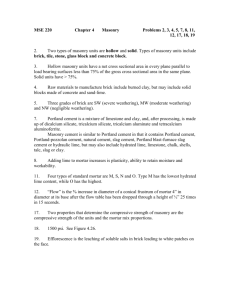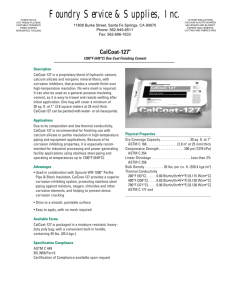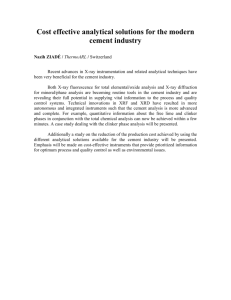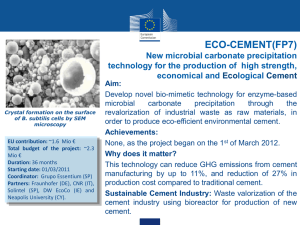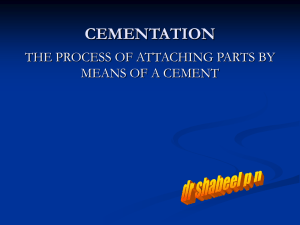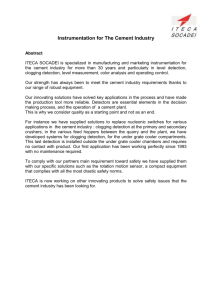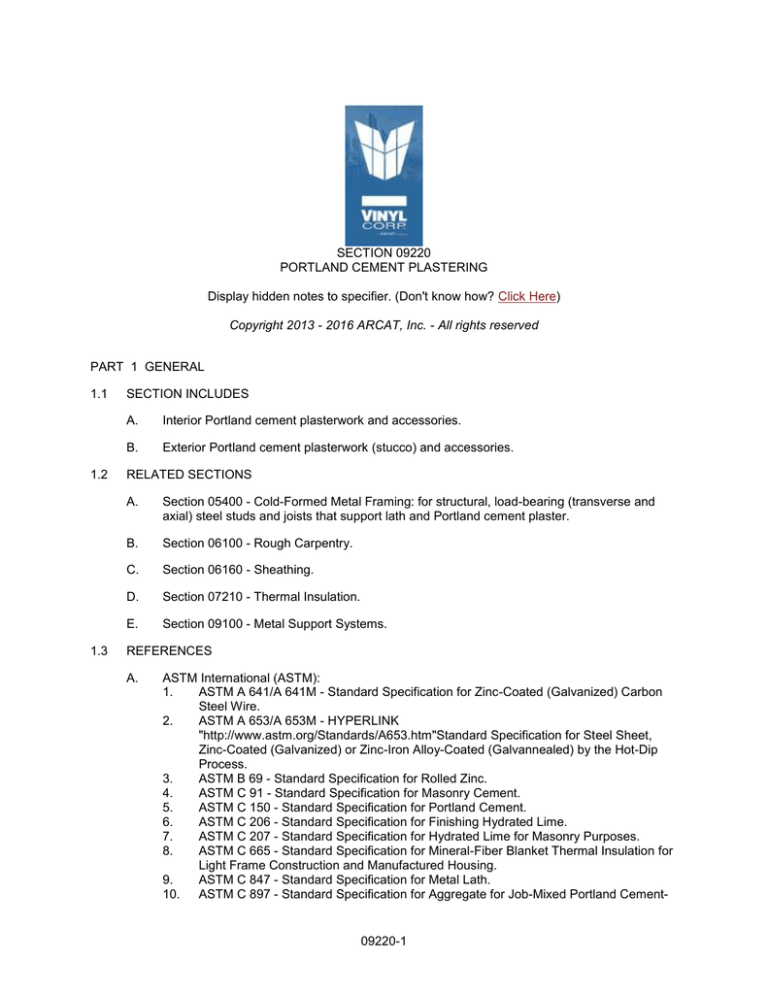
SECTION 09220
PORTLAND CEMENT PLASTERING
Display hidden notes to specifier. (Don't know how? Click Here)
Copyright 2013 - 2016 ARCAT, Inc. - All rights reserved
PART 1 GENERAL
1.1
1.2
1.3
SECTION INCLUDES
A.
Interior Portland cement plasterwork and accessories.
B.
Exterior Portland cement plasterwork (stucco) and accessories.
RELATED SECTIONS
A.
Section 05400 - Cold-Formed Metal Framing: for structural, load-bearing (transverse and
axial) steel studs and joists that support lath and Portland cement plaster.
B.
Section 06100 - Rough Carpentry.
C.
Section 06160 - Sheathing.
D.
Section 07210 - Thermal Insulation.
E.
Section 09100 - Metal Support Systems.
REFERENCES
A.
ASTM International (ASTM):
1.
ASTM A 641/A 641M - Standard Specification for Zinc-Coated (Galvanized) Carbon
Steel Wire.
2.
ASTM A 653/A 653M - HYPERLINK
"http://www.astm.org/Standards/A653.htm"Standard Specification for Steel Sheet,
Zinc-Coated (Galvanized) or Zinc-Iron Alloy-Coated (Galvannealed) by the Hot-Dip
Process.
3.
ASTM B 69 - Standard Specification for Rolled Zinc.
4.
ASTM C 91 - Standard Specification for Masonry Cement.
5.
ASTM C 150 - Standard Specification for Portland Cement.
6.
ASTM C 206 - Standard Specification for Finishing Hydrated Lime.
7.
ASTM C 207 - Standard Specification for Hydrated Lime for Masonry Purposes.
8.
ASTM C 665 - Standard Specification for Mineral-Fiber Blanket Thermal Insulation for
Light Frame Construction and Manufactured Housing.
9.
ASTM C 847 - Standard Specification for Metal Lath.
10.
ASTM C 897 - Standard Specification for Aggregate for Job-Mixed Portland Cement-
09220-1
11.
12.
13.
14.
15.
16.
17.
18.
19.
20.
21.
22.
1.4
Based Plasters.
ASTM C 926 - Standard Specification for Application of Portland Cement-Based
Plaster.
ASTM C 932 - Standard Specification for Surface-Applied Bonding Compounds for
Exterior Plastering.
ASTM C 933 - Standard Specification for Welded Wire Lath.
ASTM C 954 - Standard Specification for Steel Drill Screws for the Application of
Gypsum Panel Products or Metal Plaster Bases to Steel Studs from 0.033 in. (0.84
mm) to 0.112 in. (2.84 mm) in Thickness.
ASTM C 1002 - Standard Specification for Steel Self-Piercing Tapping Screws for the
Application of Gypsum Panel Products or Metal Plaster Bases to Wood Studs or Steel
Studs.
ASTM C 1047 - Standard Specification for Accessories for Gypsum Wallboard and
Gypsum Veneer Base.
ASTM C 1063 - Standard Specification for Installation of Lathing and Furring to
Receive Interior and Exterior Portland Cement-Based Plaster.
ASTM C 1328 - Standard Specification for Plastic (Stucco) Cement.
ASTM D 1784 - Standard Specification for Rigid Poly(Vinyl Chloride) (PVC)
Compounds and Chlorinated Poly(Vinyl Chloride) (CPVC) Compounds.
ASTM E 90 - Standard Test Method for Laboratory Measurement of Airborne Sound
Transmission Loss of Building Partitions and Elements.
ASTM E 119 - Standard Test Methods for Fire Tests of Building Construction and
Materials.
ASTM E 413 - Classification for Rating Sound Insulation.
SUBMITTALS
A.
Submit under provisions of Section 01300 - Administrative Requirements.
B.
Product Data: Manufacturer's data sheets on each product to be used, including:
1.
Preparation instructions and recommendations.
2.
Storage and handling requirements and recommendations.
3.
Installation methods.
C.
Shop Drawings: Show locations and installation of control and expansion joints including
plans, elevations, sections, details of components, and attachments to other work, based on
architectural drawings.
D.
Selection Samples: For each finish product specified, two complete sets of color chips
representing manufacturer's full range of available colors and patterns.
E.
Verification Samples: For each finish product specified, two samples, minimum size 6 inches
(150 mm) square, representing actual product, color, and patterns.
F.
LEED Submittals:
1.
Product Data for Credit MR 4.1and Credit MR 4.2: For products having recycled
content, documentation indicating percentages by weight of postconsumer and
preconsumer recycled content. Include statement indicating cost for each product
having recycled content. MR 4.1 and MR 4.2 excludes products fabricated from rigid
PVC or CPVC plastic.
2.
Product Data for Credit MR 2.1 and Credit MR 2.2: For products diverted from
disposal in landfills and incinerators, and where recycled resources are directed back
to the manufacturing process. Include statement indicating percentage of materials
diverted and recycled, and the costs associated with each. MR 2.1 and MR 2.2
excludes products fabricated from rigid PVC or CPVC plastic.
3.
Product Data for Credit MR 5: For products where product manufacturing is within a
500 mile radius of the jobsite and the point of extraction of the raw materials. Include a
09220-2
4.
5.
1.5
1.6
1.7
statement indicating the location and distances for the manufacturing plant and the
point of extraction of raw materials in relation to the jobsite location.
Product Data for Credit IEQ 4.1: For sealants, documentation including printed
statement of VOC content.
Laboratory Test Reports for Credit IEQ 4: For sealants, documentation indicating that
products comply with the testing and product requirements of the California
Department of Health Services' "Standard Practice for the Testing of Volatile Organic
Emissions from Various Sources Using Small-Scale Environmental Chambers".
QUALITY ASSURANCE
A.
Installer Qualifications: Experienced installer of lathing and plastering systems with familiarity
with manufacturer's products scheduled for the Work.
B.
Fire-Resistance Ratings: Where indicated, provide Portland cement plaster assemblies
identical to those of assemblies tested for fire resistance per ASTM E 119 by, and displaying
a classification label from, a qualified independent testing agency acceptable to the authority
having jurisdiction. Identify products with appropriate markings of applicable testing agency.
1.
Construct fire-resistance rated partitions in compliance with tested assembly
requirements indicated on drawings.
2.
Rated assemblies shall be substantiated from applicable testing using proposed
products, by Contractor.
3.
Both metal framing and wallboard manufacturers shall submit written confirmation that
it accepts the other manufacturer's product as a suitable component in the assembly.
Acceptance is as follows:
a.
If installation of both products is proper, no adverse effect will result in the
performance of one manufacturer's product by the other's product.
b.
Combining products can be substantiated by required assembly tests.
4.
Indicate design designations from UL's "Fire Resistance Directory" or from the listings
of another qualified testing agency.
C.
Sound-Transmission Characteristics: Where indicated, provide Portland cement plaster
assemblies identical to those of assemblies tested for STC ratings per ASTM E 90 and
classified according to ASTM E 413 by a qualified testing agency.
D.
Mockups: Before plastering, install mockups of at least 100 sf (9.3 sq. m) in surface area to
demonstrate aesthetic effects and set quality standards for materials and execution.
1.
Install mockups for each type of finish indicated.
2.
For interior plasterwork, simulate finished lighting conditions for review of mockups.
3.
Approved mockups may become part of the completed Work if undisturbed at time of
Substantial Completion.
E.
Preinstallation Conference: Conduct conference at Project site.
DELIVERY, STORAGE, AND HANDLING
A.
Store materials inside under cover and keep them dry and protected against damage from
weather, direct sunlight, surface contamination, corrosion, construction traffic, and other
causes.
B.
Protect cold-formed metal framing from corrosion, deformation, and other damage during
delivery, storage, and handling as required by AISI's "Code of Standard Practice".
PROJECT CONDITIONS
A.
Comply with ASTM C 926 requirements.
09220-3
B.
Interior Plasterwork: Maintain room temperatures at greater than 40 degree F (4.4 degree C)
for at least 48 hours before plaster application, and continuously during and after application.
1.
Avoid conditions that result in plaster drying out during curing period. Distribute heat
evenly; prevent concentrated or uneven heat on plaster.
2.
Ventilate building spaces as required to remove water in excess of that required for
hydrating plaster in a manner that prevents drafts of air from contacting surfaces
during plaster application and until plaster is dry.
C.
Exterior Plasterwork:
1.
Apply and cure plaster to prevent plaster drying out during curing period. Use
procedures required by climatic conditions, including moist curing, providing
coverings, and providing barriers to deflect sunlight and wind.
2.
Apply plaster when ambient temperature is greater than 40 degree F (4.4 degree C).
3.
Protect plaster coats from freezing for not less than 48 hours after set of plaster coat
has occurred.
D.
Factory-Prepared Finishes: Comply with manufacturer's written recommendations for
environmental conditions for applying finishes.
PART 2 PRODUCTS
2.1
2.2
2.3
2.4
MANUFACTURERS
A.
Acceptable Manufacturer: Vinyl Corp., which is located at: 8000 N. W. 79th Pl.; Miami, FL
33166; Toll Free Tel: 800-648-4695; Tel: 305-477-6464; Fax: 305-477-4108; Email:request
info (alstonj@vinylcorp.com); Web:www.vinylcorp.com
B.
Substitutions: Not permitted.
C.
Requests for substitutions will be considered in accordance with provisions of Section 01600
- Product Requirements.
MATERIALS
A.
Accessories for Gypsum Wallboard and Gypsum Veneer Base: ASTM C 1047.
B.
Lathing and Furring to Receive Interior and Exterior Portland Cement-Based Plaster: ASTM
C 1063.
C.
Rigid Poly (Vinyl Chloride) (PVC) Compounds and Chlorinated Poly (Vinyl Chloride) (CPVC)
Compounds: ASTM D 1784.
METAL LATH
A.
Expanded-Metal Lath: ASTM C 847, cold-rolled carbon steel sheet, ASTM A 653/A 653M,
G60 (Z180).
1.
Basis-of-Design Product: ClarkDietrich Building Systems.
B.
Wire Lath: ASTM C933, Class 1 Galvanized Coating complying with ASTM A 641.
1.
Basis-of-Design Product: Structa Wire Corp. products by ClarkDietrich Building
Systems.
ACCESSORlES
A.
Plastic Accessories for Gypsum Wallboard and Gypsum Veneer Base: ASTM C 1047.
Fabricated from plastic or plastic and paper in combination shall be manufactured from rigid
PVC, ABS, PETG, high-impact polystyrene (HIPS), or polycarbonate (PC) plastic not less
than 0.028 inch (0.7112 mm) and Section 4.3.1 PVC specification D 1784 Cell class
09220-4
13244C.
1.
Basis-of-Design Product: Vinyl Corp.
2.
Corner Beads:
a.
Vinyl Corp. "VLCB".
b.
Vinyl Corp. "VBCB".
3.
Channel Reveals: PVC reveals conforming to ASTM C 1047.
a.
Vinyl Corp. "DC-Series".
4.
Soffit Vents: Vinyl soffit vent.
a.
Vinyl Corp. "DCV-Series".
5.
Control Joints:
a.
Vinyl Corp. "CJV-Series".
2.5
B.
Plastic Accessories for Exterior Stucco: ASTM C 1063. Fabricated from plastic or plastic and
paper in combination shall be manufactured from rigid PVC, ABS, PETG, high-impact
polystyrene (HIPS), or polycarbonate (PC) plastic. Section 4.3.1 PVC specification D 1784
Cell class 13244C.
1.
Basis-of-Design Product: Vinyl Corp.
2.
Corner Beads:
a.
Vinyl Corp. "#1 Series".
3.
Casing Beads:
a.
Vinyl Corp. "66-Series".
4.
Control Joints:
a.
Vinyl Corp. "15-Series".
5.
Soffit Vents:
a.
Vinyl Corp. "V-Series".
b.
Vinyl Corp. "CS-V Series".
6.
Channel Reveals:
a.
Vinyl Corp: "CS Series".
7.
Weep Screed:
a.
Vinyl Corp. "WS- Series".
C.
Metal Accessories: Comply with ASTM A 653/A 653M, G60 (Z180).
1.
Basis-of-Design Product: ClarkDietrich Building Systems.
D.
Zinc Accessories for Portland Cement Base Plaster. ASTM B 69. Fabricated from Zinc Alloy
(99 percent pure zinc).
1.
Basis-of-Design Product: ClarkDietrich Building Systems.
MISCELLANEOUS MATERIALS
A.
Water for Mixing: Potable and free of substances capable of affecting plaster set or of
damaging plaster, lath, or accessories.
B.
Fiber for Base Coat: Alkaline-resistant glass or polypropylene fibers, 1/2 inch (13 mm) long,
free of contaminants, manufactured for use in Portland cement plaster.
C.
Bonding Compound: ASTM C 932.
D.
Steel Drill Screws: For metal-to-metal fastening, ASTM C 1002 or ASTM C 954, as required
by thickness of metal being fastened; with pan head that is suitable for application; in lengths
required to achieve penetration through joined materials of no fewer than three exposed
threads.
E.
Fasteners for Attaching Metal Lath to Substrates: Complying with ASTM C 1063.
F.
Wire: ASTM A 641/A 641M, Class 1 zinc coating, soft temper, not less than 0.0475-inch
(1.21-mm) diameter, unless otherwise indicated.
09220-5
2.6
2.7
G.
Sound Attenuation Blankets: ASTM C 665, Type I (blankets without membrane facing)
produced by combining thermosetting resins with mineral fibers manufactured from glass,
slag wool, or rock wool.
1.
Fire-Resistance-Rated Assemblies: Comply with mineral-fiber requirements of
assembly.
2.
Recycled Content: Postconsumer recycled content plus one-half of preconsumer
recycled content not less than ___ percent by weight.
H.
Acoustical Sealant:
1.
As specified in Section 07 91 26 - Joint Fillers - Joint Sealants.
2.
Sealants shall have a VOC content of 250 g/L or less when calculated according to 40
CFR 59, Subpart D (EPA Method 24).
3.
Sealants shall comply with the testing and product requirements of the California
Department of Health Services' "Standard Practice for the Testing of Volatile Organic
Emissions from Various Sources Using Small-Scale Environmental Chambers."
PLASTER MATERIAL
A.
Portland Cement: ASTM C 150, Type I.
B.
Portland Cement: ASTM C 150, Type II.
C.
Masonry Cement: ASTM C 91, Type N.
D.
Plastic Cement: ASTM C 1328.
E.
Colorants for Job-Mixed Finish Coats: Colorfast mineral pigments that produce finish plaster
color to match Architect's sample.
F.
Lime: ASTM C 206, Type S; or ASTM C 207, Type S.
G.
Sand Aggregate: ASTM C 897.
1.
Color for Job-Mixed Finish Coats: White.
2.
Color for Job-Mixed Finish Coats: In color matching Architect's sample.
H.
Perlite Aggregate: ASTM C 35.
I.
Exposed Aggregates for Finish Coats: For marblecrete finish, clean, sound, crushed marble
matching color and size gradation of Architect's sample.
J.
Ready-Mixed Finish-Coat Plaster: Mill-mixed Portland cement, aggregates, coloring agents,
and proprietary ingredients.
K.
Acrylic-Based Finish Coatings: Factory-mixed acrylic-emulsion coating systems, formulated
with colorfast mineral pigments and fine aggregates; for use over Portland cement plaster
base coats. Include manufacturer's recommended primers and sealing topcoats for acrylicbased finishes.
PLASTER MIXES
A.
General: Comply with ASTM C 926 for applications indicated.
1.
Fiber Content: Add fiber to base-coat mixes after ingredients have mixed at least two
minutes. Comply with fiber manufacturer's written instructions for fiber quantities in
mixes, but do not exceed 1 lb of fiber/cu. yd. (0.6 kg of fiber/cu. m) of cementitious
materials.
B.
Base-Coat Mixes for Use over Metal Lath: Scratch and brown coats for three-coat
plasterwork as follows:
09220-6
1.
2.
3.
4.
5.
Portland Cement Mixes:
a.
Scratch Coat:
1)
For cementitious material, mix 1 part Portland cement and 0 to 3/4 parts
lime.
2)
For cementitious material, mix 1 part Portland cement and 3/4 to 1-1/2
parts lime.
3)
Use 2-1/2 to 4 parts aggregate per part of cementitious material.
b.
Brown Coat:
1)
For cementitious material, mix 1 part Portland cement and 0 to 3/4 parts
lime.
2)
For cementitious material, mix 1 part Portland cement and 3/4 to 1-1/2
parts lime.
3)
Use 3 to 5 parts aggregate per part of cementitious material, but not less
than volume of aggregate used in scratch coat.
Masonry Cement Mixes:
a.
Scratch Coat: 1 part masonry cement and 2-1/2 to 4 parts aggregate.
b.
Brown Coat: 1 part masonry cement and 3 to 5 parts aggregate, but not less
than volume of aggregate used in scratch coat.
Portland and Masonry Cement Mixes:
a.
Scratch Coat: For cementitious material, mix 1 part Portland cement and 1 part
masonry cement. Use 2-1/2 to 4 parts aggregate per part of cementitious
material.
b.
Brown Coat: For cementitious material, mix 1 part Portland cement and 1 part
masonry cement. Use 3 to 5 parts aggregate per part of cementitious material,
but not less than volume of aggregate used in scratch coat.
Plastic Cement Mixes:
a.
Scratch Coat: 1 part plastic cement and 2-1/2 to 4 parts aggregate.
b.
Brown Coat: 1 part plastic cement and 3 to 5 parts aggregate, but not less than
volume of aggregate used in scratch coat.
Portland and Plastic Cement Mixes:
a.
Scratch Coat: For cementitious material, mix 1 part plastic cement and 1 part
Portland cement. Use 2-1/2 to 4 parts aggregate per part of cementitious
material.
b.
Brown Coat: For cementitious material, mix 1 part plastic cement and 1 part
Portland cement. Use 3 to 5 parts aggregate per part of cementitious material,
but not less than volume of aggregate used in scratch coat.
C.
Base-Coat Mixes: Single base coats for two-coat plasterwork as follows:
1.
Portland Cement Mix: For cementitious material, mix 1 part Portland cement and 0 to
3/4 part lime. Use 2-1/2 to 4 parts aggregate per part of cementitious material.
2.
Portland and Masonry Cement Mix: For cementitious material, mix 1 part Portland
cement and 1 part masonry cement. Use 2-1/2 to 4 parts aggregate per part of
cementitious material.
3.
Plastic Cement Mix: Use 1 part plastic cement and 2-1/2 to 4 parts aggregate.
D.
Base-Coat Mixes: Single base coats for two-coat plasterwork as follows:
1.
Portland Cement Mix: For cementitious material, mix 1 part Portland cement and 3/4
to 1-1/2 parts lime. Use 2-1/2 to 4 parts aggregate per part of cementitious material.
2.
Masonry Cement Mix: Use 1 part masonry cement and 2-1/2 to 4 parts aggregate.
3.
Plastic Cement Mix: Use 1 part plastic cement and 2-1/2 to 4 parts aggregate.
E.
Job-Mixed Finish-Coat Mixes:
1.
Portland Cement Mix: For cementitious materials, mix 1 part Portland cement and 3/4
to 1-1/2 parts lime. Use 1-1/2 to 3 parts aggregate per part of cementitious material.
2.
Portland Cement Mix: For cementitious materials, mix 1 part Portland cement and 11/2 to 2 parts lime. Use 1-1/2 to 3 parts aggregate per part of cementitious material.
09220-7
3.
4.
5.
F.
Masonry Cement Mix: 1 part masonry cement and 1-1/2 to 3 parts aggregate.
Portland and Masonry Cement Mix: For cementitious materials, mix 1 part Portland
cement and 1 part masonry cement. Use 1-1/2 to 3 parts aggregate per part of
cementitious material.
Plastic Cement Mix: 1 part plastic cement and 1-1/2 to 3 parts aggregate.
Factory-Prepared Finish-Coat Mixes: For ready-mixed finish-coat plasters and acrylic-based
finish coatings, comply with manufacturer's written instructions.
PART 3 EXECUTION
3.1
3.2
3.3
3.4
EXAMINATION
A.
Examine areas and substrates, with Installer present, and including welded hollow-metal
frames, cast-in anchors, and structural framing, for compliance with requirements and other
conditions affecting performance of the Work.
B.
Proceed with installation only after unsatisfactory conditions have been corrected.
PREPARATION
A.
Protect adjacent work from soiling, spattering, moisture deterioration, and other harmful
effects caused by plastering.
B.
Prepare solid substrates for plaster that are smooth or that do not have the suction capability
required to bond with plaster according to ASTM C 926.
INSTALLATION, GENERAL
A.
Fire-Resistance-Rated Assemblies: Install components according to requirements for design
designations from listing organization and publication indicated on Drawings.
B.
Sound Attenuation Blankets: Where required, install blankets before installing lath unless
blankets are readily installed after lath has been installed on one side.
C.
Acoustical Sealant: Where required, seal joints between edges of plasterwork and abutting
construction with acoustical sealant.
INSTALLING METAL LATH
A.
3.5
Expanded-Metal Lath: Install according to ASTM C 1063.
1.
Partition Framing and Vertical Furring: Install flat diamond-mesh lath.
2.
Partition Framing and Vertical Furring: Install flat rib lath.
3.
Partition Framing and Vertical Furring: Install welded-wire lath.
4.
Partition Framing and Vertical Furring: Install woven-wire lath.
5.
Flat-Ceiling and Horizontal Framing: Install flat diamond-mesh lath.
6.
Flat-Ceiling and Horizontal Framing: Install flat rib lath.
7.
Flat-Ceiling and Horizontal Framing: Install 3/8-inch (9.5-mm) rib lath.
8.
Flat-Ceiling and Horizontal Framing: Install welded-wire lath.
9.
Flat-Ceiling and Horizontal Framing: Install woven-wire lath.
10.
Curved-Ceiling Framing: Install flat diamond-mesh lath.
11.
Curved-Ceiling Framing: Install welded-wire lath.
12.
Curved-Ceiling Framing: Install flat woven-wire lath.
13.
On Solid Surfaces, Not Otherwise Furred: Install self-furring, diamond-mesh lath.
14.
On Solid Surfaces, Not Otherwise Furred: Install self-furring, welded-wire lath.
15.
On Solid Surfaces, Not Otherwise Furred: Install self-furring, woven-wire lath.
INSTALLING WELDED WIRE LATH
09220-8
A.
3.6
3.7
Installation per ESR 2017 - Fastener type and spacing as per ASTM C 1063 except that
fasteners may attach the lath to framing supports either at the furring crimps on the vertical
cross wire, at the intersection of the longitudinal wire and cross wire or any point along the
longitudinal wires.
1.
Product: Structa Wire Corp. Structalath by ClarkDietrich Building Systems.
INSTALLING ACCESSORIES
A.
Install according to ASTM C 1063 and at locations indicated on Drawings.
B.
Reinforcement for External Corners:
1.
Install lath-type, external-corner reinforcement at exterior locations.
2.
Install corner bead at interior corner locations.
3.
Install corner bead at exterior corner locations.
C.
Control Joints:
1.
Install control joints at locations indicated on Drawings.
2.
Install control joints in specific locations approved by Architect for visual effect as
follows:
a.
______.
3.
As required to delineate plasterwork into areas (panels) of the following maximum
sizes:
a.
Vertical Surfaces: 144 sq. ft. (13.4 sq. m).
b.
Horizontal and other Nonvertical Surfaces: 100 sq. ft. (9.3 sq. m).
4.
At distances between control joints of not greater than 18 feet (5.5 m) o.c.
5.
As required to delineate plasterwork into areas (panels) with length-to-width ratios of
not greater than 2-1/2:1.
6.
Where control joints occur in surface of construction directly behind plaster.
7.
Where plasterwork areas change dimensions, to delineate rectangular-shaped areas
(panels) and to relieve the stress that occurs at the corner formed by the dimension
change.
PLASTER APPLICATION
A.
General: Comply with ASTM C 926.
1.
Do not deviate more than plus or minus 1/4 inch in 10 feet (6.4 mm in 3 m) from a true
plane in finished plaster surfaces, as measured by a 10-foot (3-m) straightedge placed
on surface.
2.
Finish plaster flush with metal frames and other built-in metal items or accessories
that act as a plaster ground unless otherwise indicated. Where casing bead does not
terminate plaster at metal frame cut base coat free from metal frame before plaster
sets and groove finish coat at junctures with metal.
3.
Provide plaster surfaces that are ready to receive field-applied finishes indicated.
B.
Bonding Compound: Apply on unit masonry and concrete plaster bases.
C.
Walls; Base-Coat Mixes for Use over Metal Lath: Scratch and brown coats for three-coat
plasterwork; 3/4-inch (19-mm) thickness.
1.
Portland cement mixes.
2.
Masonry cement mixes.
3.
Portland and masonry cement mixes.
4.
Plastic cement mixes.
5.
Portland and plastic cement mixes.
D.
Ceilings; Base-Coat Mixes for Use over Metal Lath: Scratch and brown coats for three-coat
plasterwork; 1/2 inch (13 mm) thick and 3/4 inch (19 mm) thick on concrete.
1.
Portland cement mixes.
09220-9
2.
3.
4.
5.
3.8
E.
Walls; Base-Coat Mix: Scratch coat for two-coat plasterwork, 3/8 inch (10 mm) thick on
concrete masonry and 1/4 inch (6 mm) thick on concrete.
1.
Portland cement mixes.
2.
Masonry cement mixes.
3.
Portland and masonry cement mixes.
4.
Plastic cement mixes.
5.
Portland and plastic cement mixes.
F.
Ceilings; Base-Coat Mix: Scratch coat for two-coat plasterwork, 1/4 inch (6 mm) thick on
concrete.
1.
Portland cement mixes.
2.
Masonry cement mixes.
3.
Portland and masonry cement mixes.
4.
Plastic cement mixes.
5.
Portland and plastic cement mixes.
G.
Plaster Finish Coats:
1.
Apply to provide float finish to match Architect's sample.
2.
Apply to provide dash finish to match Architect's sample.
3.
Apply to provide scraped trowel-textured finish to match Architect's sample.
4.
Apply to provide skip trowel-textured finish to match Architect's sample.
5.
Apply to provide brocade (knock-down dash) finish to match Architect's sample.
6.
Apply to provide trowel sweep finish to match Architect's sample.
7.
Apply to provide combed finish to match Architect's sample.
8.
Apply to provide sacked (California mission) finish to match Architect's sample.
9.
Apply to provide English finish to match Architect's sample.
10.
Apply to provide marblecrete finish to match Architect's sample.
H.
Acrylic-Based Finish Coatings: Apply coating system, including primers, finish coats, and
sealing topcoats, according to manufacturer's written instructions.
I.
Concealed Exterior Plasterwork: Where plaster application will be used as a base for
adhered finishes, omit finish coat.
J.
Concealed Interior Plasterwork:
1.
Where plaster application will be concealed behind built-in cabinets, similar
furnishings, and equipment, apply finish coat.
2.
Where plaster application will be concealed above suspended ceilings and in similar
locations, finish coat may be omitted.
3.
Where plaster application will be used as a base for adhesive application of tile and
similar finishes, omit finish coat.
PLASTER REPAIRS
A.
3.9
Masonry cement mixes.
Portland and masonry cement mixes.
Plastic cement mixes.
Portland and plastic cement mixes.
Repair or replace work to eliminate cracks, dents, blisters, buckles, crazing and check
cracking, dry outs, efflorescence, sweat outs, and similar defects and where bond to
substrate has failed.
PROTECTION
A.
Remove temporary protection and enclosure of other work. Promptly remove plaster from
door frames, windows, and other surfaces not indicated to be plastered. Repair floors, walls,
09220-10
and other surfaces stained, marred, or otherwise damaged during plastering.
END OF SECTION
09220-11

